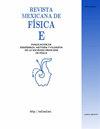随机漫步,预测选举结果和统计物理
Q4 Social Sciences
引用次数: 0
摘要
几个重要的统计工具和概念涵盖在高年级本科统计物理课程,包括随机游走和中心极限定理。然而,学生们往往忽略了它们的一些广泛适用性,以及它们与其他物理概念之间的联系。在这项工作中,我们应用一维随机漫步来研究候选人在领先于对手的情况下赢得选举的概率演变,并将发现的结果与状态密度和职业概率的概念联系起来。本文旨在为统计物理讲师提供指南,以激励学生超越官方教学大纲的界限。本文章由计算机程序翻译,如有差异,请以英文原文为准。
On random walks, projecting election results and statistical physics
Several important statistical tools and concepts are covered in upper division undergraduate Statistical Physics courses, including those of random walks and the central limit theorem. However, some of their broad applicability tends to be missed by students as well as the connection between these and other physical concepts. In this work, we apply a 1D random walk to study the evolution of the probability that a candidate will win an election given she holds some lead over her opponent, and connect the result found to the concept of density of states and occupation probabilities. This paper is intended to serve as a guide to the Statistical Physics instructor who wishes to motivate students beyond the boundaries of the official syllabus.
求助全文
通过发布文献求助,成功后即可免费获取论文全文。
去求助
来源期刊

Revista Mexicana De Fisica E
社会科学-科学史与科学哲学
CiteScore
0.80
自引率
0.00%
发文量
14
审稿时长
>12 weeks
期刊介绍:
The Revista Mexicana de Física (Rev. Mex. Fis.) publishes original papers of interest to our readers from the physical science com unity. Language may be English or Spanish, however, given the nature of our readers, English is recommended. Articles are classified as follows:
Research. Articles reporting original results in physical science.
Instrumentation. Articles reporting original contributions on design and construction of scientific instruments. They should present new instruments and techniques oriented to physical science problems solutions. They must also report measurements performed with the described instrument.
Reviews. Critical surveys of specific physical science topics in which recent published information is analyzed and discussed. They should be accessible to physics graduate students and non specialists, and provide valuable bibliography to the specialist.
Comments. Short papers (four pages maximum) that assess critically papers by others authors previously published in the Revista Mexicana de Física. A comment should state clearly to which paper it refers.
 求助内容:
求助内容: 应助结果提醒方式:
应助结果提醒方式:


